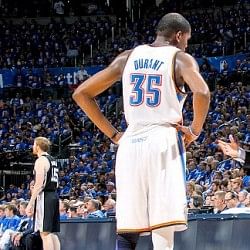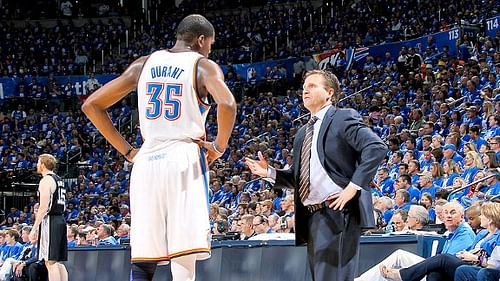
2014 NBA Playoffs: What were they thinking? Brooks and McHale hurting the Thunder and the Rockets
By Ryan Rodriguez
The NBA playoffs are just a week and a day old, and yet I feel like I have aged 2 months already, as seemingly every game has been decided on the last possession of the game. As basketball fans, we have been inundated with so much drama, game after game, that we are essentially repeating ourselves as we search for words to describe what just transpired between the Blazers-Rockets (or was it Grizzlies-Thunder, or maybe it was the Mavericks-Spurs). With each passing game, we also get to watch how coaches adjust to the heightened pressure of a tight playoff game, what plays they run, how they juggle offensive/defensive substitutions, or what kind of system they teach their players so they can fall back on a winning offensive and defensive strategy when chaos ensues.

This brings me to two Western Conference coaches, Scott Brooks of the Thunder and Kevin McHale of the Rockets, who are both facing tough series from lower seeded teams. Each coach has copped flack, both this year and in years past, for employing offensive systems that leave much to be desired at the end of games, delving into a lot of ball stopping sets that allow defenses to gear up to stop the one threat on that possession.
As I watched both of these teams play their fourth straight tight game of the playoffs, I found myself becoming increasingly frustrated despite having no rooting interest in either game other than wanting the best, most drama-filled game possible. But watching Kevin Durant try to post up a relentless Tony Allen, or watching the Rockets eschew the pick and roll for another Dwight Howard post-up, just left me with an uneasy feeling and lack of fulfilment to what could have been much better end-of-game plans.
Watching these teams reminded me of Albert Einstein’s definition of insanity, “doing the same thing over and over again expecting different results”, as the Thunder thought they could shake 2.5 series worth of evidence that Allen was a KD antidote, while the Rockets seem insistent on proving seasons of unflattering data of Dwight post-up efficiency wrong.
The Thunder essentially have three plays that they run the majority of the time once the clock gets under three minutes, either the pin-down screen for KD to curl up and catch the ball around the free throw line, a Paul Pierce style post-up for KD around the free throw line, or a crazy Russell Westbrook shot; either because he is crazy or he’s realized that KD isn’t getting open and there are only five seconds left on the shot clock.
The common theme in all of these offensive “plays” are that they all consist of one option and show no signs of a system in place to create movement and confusion on the defense’s part. You can get away with this stuff in the regular season when teams are not focused on one opponent for an extended period, but when you have a team dialled into all your intricacies, and a top defensive team like the Grizzlies at that, simple, one action plays are just not going to work. If a rudimentary basketball strategist like myself can deduce what the Thunder are going to run, I can only imagine the smile on the faces of every Grizzlies player as they see the clock tick under three minutes of another tight game against OKC, knowing full well what to expect on defense.
Here is a clip from Game 2 when the Thunder were fighting back from a deficit looking to force overtime.
The first thing that is readily apparent is how Tony Allen easily gets around the pin-down he knows is coming, denies KD, and sends OKC into scramble mode to get a bucket. This is because Allen is an expert at ball denial, but also because he knows what is coming. Now, watch again, and notice how the other three Thunder players barely move, just standing in their spots waiting for a kick out or, in this case, to set a screen on Russ’s man so he can get a switch and go into iso mode.
Here’s another clip from overtime of Game 2. Off the inbound, notice the action that the Thunder use.
If it is eerily similar to the first clip it should be. They run the exact same play, only adding an Ibaka roll, something that looks more of a product of a higher screen and quicker pass to KD rather than an intrinsic new wrinkle designed to get an open look. You still have two people doing nothing to set themselves up for a shot (or any help to get them open as a secondary option) and, once again, Ibaka’s cut seems to only take place once KD is bottled up off the drive.
Per numbers from Sports VU that I found in a Royce Young article on Daily Thunder, the Thunder had 230 total passes in Game 3, including 11 passes on 22 possessions in the fourth quarter. I didn’t know if 230 passes was a lot or not (from further research it is a low number), but I do know an average of 1 pass on every 2 possessions is downright horrible. This isn’t an isolated game either; the Thunder had 239 passes in Game 1, 261 in Game 2 (with OT), and, from the regular season, 279 against the Clippers and 229 against the Spurs.
Compare this with the Grizzlies from Game 3 – 367 passes – and you get numbers that match up with what you see when watching the Thunder, they are an iso team.
To me, this is a Scott Brooks problem, being as he is the designer of the team’s schemes. He fails game after game and season after season to inject movement and sophistication into the Thunder’s end-of-game offense, whether it be a few new plays or actions to get their stars the ball or some false action on one side of the court to get the defense moving, while setting up their real play for KD or Russ on the other side of the court. Watch the Mavs, Spurs or Heat and you will see multiple times where they run a pick and roll on one side of the court only to swing it to Monta Ellis, Tony Parker, or LeBron James on the other side for a high-speed pick and roll. Simple things like this will force the Grizzlies to take their sole focus off of KD and Russ and allow these two some space and new lanes with which to attack and cause devastation.
As for the Rockets, I just do not get the Dwight-in-the-post infatuation they have. Don’t get me wrong, I don’t think Dwight is some stiff who can’t score when he gets the ball in the post, and sometimes his post failures can be overblown, but no one in their right mind can argue that throwing the ball to Dwight in the post gives them the best chance to win. Once again, as with the Thunder, the stats back up everything we see with our eyes. Simply put, rejiggering their high screens, spread the floor, improve-against-defense’s-reactions offense and throwing the ball repeatedly into the post to Dwight is a losing proposition.
Take Game 2 for example, when the Rockets ran 13 post-ups for Dwight according to Synergy Sports, and he produced 10 points and no fouls for a score of 0.77 points per possession. What makes it even worse, Dwight also does a bad job of getting shots up every time he gets the ball in the post, ranking with the highest turnover rate on post-ups among high usage bigs this season, according to Tom Haberstroh of ESPN.
People might want to argue that the points per possession is a single game anomaly, but all the way back in January, Matt Moore of CBS Sports Eye on Basketball gave us this fabulous table, showing how Dwight does on each type of scoring chance he gets and the frequency with which he gets them.

First, his points per possession on post-ups look eerily similar to what he posted for Game 2 of the Western Conference playoff series against the Blazers. Second, while we know that post-ups aren’t the most efficient shots in the game, is there any reason that Dwight shouldn’t be prominently featured in the pick and roll, where he is almost a 70% shooter?
Granted his roll-man shooting opportunities are much fewer than his post-up opportunities, but that still is a 25% shooting difference showing right there. Imagine a poor defensive team like the Blazers trying to contend with a Harden/Howard or Lin/Howard pick and roll. If you think it’s scary you should – both Harden and Lin shoot over 48% on drives according to SportVU (top 25 in the league) – and that is factoring in all drives (isos, pick and rolls, and catch and drives). Imagine if the Blazers had to deal with drive after drive from these two while also dealing with a roll man who shoots 70% on such actions.
What makes it even worse is that Kevin McHale seems set on practising insanity. Its like he hasn’t watched Dwight over his career or has blocked out the fact that Dwight’s most successful run as an offensive force came as the roll-man for Stan Van Gundy’s 4-in-1-out pick and roll based offense. Can you give Dwight a few post-ups a game to whet his appetite, yeah, its not like you are throwing the ball into Roy Hibbert or something, but to have that be the mode with which Dwight most frequently works out off, well that’s just not smart basketball.
The good thing for both of these coaches is that they still have time to correct the insanity they are suffering from. The Thunder, for all their shooting woes, are in control of the series with two home games left in what is now a best of three, while the Rockets can win Game 5, steal Game 6 at Portland, then return home tied for all the marbles. Each team is more than capable of winning their series and taking their warts into the second round, but they need their coaches to stop wasting possession and put their team in the best position to win games. And to me, that is the biggest question facing these teams, and in turn, their franchises going forward.